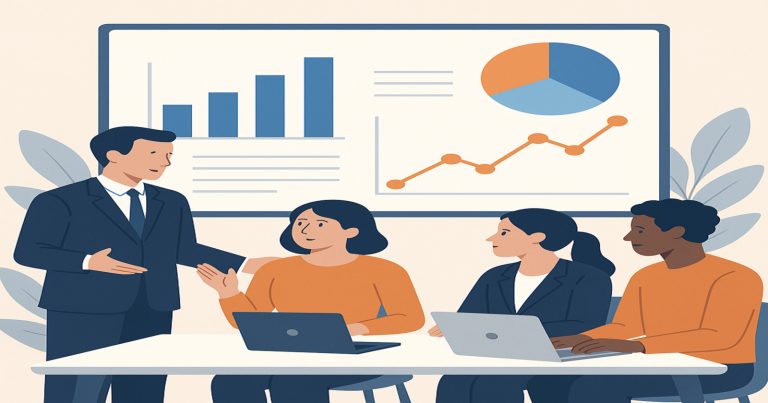Understanding stakeholder analysis techniques helps every business plan better and grow faster. When a company knows who its stakeholders are and how they feel, it can avoid problems. It can also build stronger relationships. Companies that do stakeholder analysis can choose better business growth strategies. They make smart decisions. These decisions help them move forward and become stronger in the market.
Stakeholder analysis techniques tell you who your stakeholders are. They also show how much power each one has. This analysis gives clear steps to manage each stakeholder well. Study what stakeholder analysis is, why it matters, what types exist, which techniques work best, and the theories behind them.
What is Stakeholder Analysis?
Every business or project has people who affect it. These people are called stakeholders. Stakeholder analysis is the way to find out who they are, what they want, and how much power they have. Different stakeholder analysis techniques can give business leaders insight into these people.
Defining Stakeholder Analysis in Simple Terms
Stakeholder analysis means finding out who will be affected by a project or a business. It also means finding out who can affect the project or business in return. These people can be customers, investors, employees, or even the local community. The process uses different stakeholder analysis techniques to study their interest and influence. It shows who supports the project and who may stop it.
For example, if a company wants to open a new branch, it must look at the people who live near that place. The business must also think about local laws and its employees. It needs to use stakeholder analysis techniques to manage all these people’s needs. When done well, this helps the company avoid delays and gain support.
Stakeholder analysis also helps in planning communication. Some need more data than others. A savvy entrepreneur applies this framework in determining how much to speak, what to speak on and when to speak. This prevents confusion and helps build trust.
Stakeholder Analysis: Why is it Important?
Stakeholder analysis is more than a useful tool. It is necessary. It assists organizations understand their individuals as well as take care of change the means it need to be. It also minimizes risk and saves time.
Every Business Needs Stakeholder Analysis, Here is Why
Every business has to take decision. Decisions can be big, like launching a product. Others are small, such as changing a service. These decisions have consequences, big or small, for real people. Things can go wrong if a business does not factor these people in. Stakeholder analysis ensures that all voices are heard.
Stakeholder analysis techniques guide leaders in finding the most powerful stakeholders. These people can make or break a plan. When a business knows who they are, it can talk to them first. This helps in building support early. If the business waits too long, these stakeholders may stop the plan.
One more reason stakeholder analysis is important is because it reduces risks. Every project has risks. But not all risks come from outside. Some risks come from inside. Employees, for example, can feel unhappy if they are not informed. Customers may leave if they don’t agree with changes. Stakeholder analysis techniques help leaders see these risks early.
Good stakeholder analysis also helps in saving time and money. When everyone agrees from the start, there are fewer changes later. The plan runs smoothly. There are no delays. The business finishes its goals faster.
In short, stakeholder analysis gives the full picture. It prepares leaders to manage people better. It also makes business growth another area that has little sorrow, and is more likely to succeed in a flowing flow.
Types of Stakeholder Analysis
In this variation, we will analyze using a few classes of stakeholders. Each of those produces a different result. The businesses have to be choosy over that one which would serve their purpose. Some focus on interest. Others focus on power. Some mix both. Stakeholder analysis techniques are needed for all of those.
Power-interest grid analysis
It categorizes stakeholders into four groups. These groups rely on the extent of their power, and of their interest. You have also learned that people with high power and high interest need more attention. If they have low power and low interest, they need even less.
Influence-impact analysis
This views the extent to which a stakeholder can shape the project. It also appreciates how the project can touch them. This can be beneficial when different stakeholders have other needs.
Analysis of attitude.
This determines if the stakeholders are positive, negative or neutral about the project. It also indicates whether their attitude could change. This gives companies advance notice so they can prepare for crises.
Relationship analysis
This assesses the interaction of the stakeholders. Some may work together. Others may disagree. Intuitive synopsis of similar patterns makes for more accurate planning and less baffling surprises.
| Type of Stakeholder Analysis | Focus Area | Purpose |
| Power-Interest Grid | Power and Interest | Prioritize stakeholders |
| Impact-Influence Matrix | Impact, Influence | Effective in large projects |
| Stakeholder attitude | Stakeholder sentiment | Supports message strategy |
| Relationship Analysis | Stakeholder Links | Helps Calculate group planning |
Most enterprises also combine several types. They choose what suits their needs best. All these types form the base of strong stakeholder analysis techniques.
Techniques Used for Stakeholder Analysis
Each stakeholder analysis method “needs” a technique. They are straightforward actions to take. They help find, organize and manage stakeholders. In general, they are members of the stakeholder management plan. These are stakeholder analysis techniques:
Stakeholder Identification Analysis techniques
These ways assist in maintaining an inventory of all stakeholders. Educators implement interviews, workshops or surveys. They ask questions, too, to identify who matters and by how much.
Mapping Method
They use grids, for example, the power-interest grid. How do leaders use colors or notes to put people in the appropriate location on the grid? This aids in determining who requires additional attention.
Influence Mapping
This tests how influential a stakeholder is and if they can impact others. If one person influences lots of others, they need to be looked after differently.
Communication Planning techniques
Businesses need to talk to stakeholders after identifying and mapping. These techniques strategize what to say and when and how to say it. Some people need meetings. Others need emails.
| Technique | Purpose | Common Tools Used |
| Stakeholder Identification Analysis Technique | To find all stakeholders | Interviews, Surveys |
| Power-Interest Grid Mapping | To sort stakeholders | Charts, Sticky Notes |
| Influence Mapping | To find stakeholder connections | Influence Diagrams |
| Communication Planning | To design communication | Plans, Calendars |
Each technique supports the next. Together, they form a full stakeholder plan. These are the most reliable techniques used for stakeholder analysis.
Stakeholder Analysis Theory
Stakeholder analysis theory outlines the thinking behind each step. It explains why we need to study stakeholders. These are your roadmaps to creating techniques and developing models that work.
Freeman’s Stakeholder Theory
It’s a message that companies need to care about all stakeholders, not just those who pay them. Labor, communities and so on. When businesses care about all stakeholders, they become stronger.
Salience Model
This model is helpful in order to ranked stakeholders. It considers three things – power, legitimacy, and urgency. They are the most important stakeholder of all three roles. This model tells us where to prioritize our attention.
Mitchell, Agle, and Wood theory
It explains how stakeholder roles change with time. A stakeholder who is weak today may be strong tomorrow. This helps in updating the analysis often.
This is all part of the reason stakeholder analysis is not a once and done job. It is a continuous process. In order for leaders to keep smart and ready for any change, the stakeholder analysis theory helps.
To get powerful results, you can use stakeholder analysis theory and techniques together. It enhances business productivity and strengthens planning.
Relevance to ACCA Syllabus
Stakeholder analysis techniques is a key topic within ACCA’s Strategic Business Leader (SBL) paper. It scans stakeholders’ power and interest, and is central to strategic planning, ethics and corporate governance.
Stakeholder Analysis Techniques ACCA Questions
Q1: What is the common framework used for classifying stakeholders according to level of power and interest under ACCA?
A) RACI Matrix
B) Mendelow’s Matrix
C) Ansoff Matrix
D) Balanced Scorecard
Answer: B) Mendelow’s Matrix
Q2: Stakeholder theory states that an organization should: A. Manage stakeholders that have power over them and are highly interested in terms of the information they receive and talk about.
A) Monitor them
B) Keep them satisfied
C) Ignore them
D) Empower them
Answer: B) Keep them satisfied
Q3: Stakeholder with low power and interest should be:
A) Kept satisfied
B) Closely managed
C) Easy to monitor
D) Having the power to decide
Answer: C) There is almost no effort to monitor.
Q4: An example of an external stakeholder is?
A) Line manager
B) Internal auditor
C) Government body
D) Shareholder analyst
Answer: C) Government body
Q5: This is why stakeholder analysis is key in business leadership.
A) It enhances product quality
B) It Enhances Financial Reporting
C) It assists to associate strategy with stakeholder expectations
D) It lowers the turnover rate of employees
Answer: C) It can align strategy with the expectations of stakeholders
Relevance to US CMA Syllabus
Stakeholder analysis is key for performance management (especially US CMA (Part 1 & 2)), under strategic planning requirements, ethical decision making, internal & external influence.
Stakeholder Analysis Techniques US CMA Questions
Q1: Why is it important to do a stakeholder analysis when assessing performance?
A) Reducing product cost
B) Identifying budgeting gaps
C)Who this decision impacts or who impacts the decision
D) Tracking product defects
Answer: C) Knowing the players in your game.
Q2: People with high interest and low power should be:
A) Ignored
B) Empowered
C) Kept informed
D) Made shareholders
Answer: C) Kept informed
Q3: In which matrix you use to visualisation of stakeholder position based on influence and concern?
A) Gantt Chart
B) Responsibility Matrix
C) Power/Interest Grid
D) CVP Chart
Answer: C) Power/Interest Grid
Q4: From below, the most likely key internal stakeholder in management accounting is
A) Shareholders
B) Board of directors
C) Competitors
D) External auditors
Answer: B) Board of directors
Q5: What role stakeholder as affected party would play in the decision-making process of a CMA?
A) To enhance profit margins
B) For the sake of ethics and accountability
C) To reduce product defects
D) To comply with export control laws
Answer: B) We should enhance ethics and accountability
Relevance to CFA Syllabus
Stakeholder theory is in the CFA curriculum (Ethics, Corporate Governance & ESG Investing). It’s critical in assessing corporate responsibility and investment decisions and sustainability analysis.
Stakeholder Analysis Techniques CFA Questions
Q1: What is the governance theory that argues that stakeholder interests should be balanced against one another rather than talking just about shareholders?
A) Agency theory
B) Stakeholder theory
C) Market efficiency theory
D) Modigliani-Miller theory
Answer: B) Stakeholder theory
Q2: Which stakeholder is usually deemed high power, high interest?
A) Institutional investors
B) Credit rating agencies
C) Local community groups
D) Small retail investors
Answer: A) Institutional investors
Q3: In ESG investing, stakeholder analysis will help investors:
A) Predict currency movements
B) Assess non-financial risks and business implications
C) Increase bond yields
D) Avoid interest rate risk
Answer: B) Analyze business and corporate impacts of non-financial risks
Q4: If you do not properly manage stakeholders, things can go wrong which results in:
A) Stronger dividend growth
B) Higher credit ratings
(C) Reputational and regulatory risks
D) Improved asset turnover
Answer: C) regulatory and reputational risk
Q5: What of these tools you believe is the easiest to use to classify stakeholders in the ESG analysis?
A) CAPM
B) DuPont Analysis
C) Power/Interest Matrix
D) Yield Curve
Answer: C) Power/Interest Matrix
Relevance to US CPA Syllabus
Stakeholder analysis is relevant in areas of CPA’s ethics, auditing, and governance. Stakeholders influence the future of corporations, so CPAs need to prepare transparent financial information and accountability in their fiduciary responsibilities.
Stakeholder Analysis Techniques US CPA Questions
Q1: Why stakeholder analysis is required in the audit planning?
A) To lower tax burdens
B) To increase client retention
C) To provide line of defence on stakeholder expectation related risk areas
D) To manipulate earnings
Answer: C) As it helps the organization to understand and manage risk areas generated by stakeholder expectations
Q2: Which stakeholder group most cares about the accuracy and transparency of the financial statement?
A) Customers
B) Competitors
C) Investors
D) Employees
Answer: C) Investors
Q3: What is the Power/Interest Grid model used for in stakeholder analysis?
A) To assess audit fees
B) To group stakeholders with whom engagement strategy can be made
C) Materiality — to accordingly materiality threshold
D) To compute deductible depreciation for tax
Answer: B) For Stakeholder Engagement Strategy classification
Q4: Which of these stakeholder groups generally has a governance role over financial audits?
A) Creditors
B) Taxpayers
C) Government agencies
D) Vendors
Answer: C) Government agencies
Q5: What is the rationale behind CPAs assessing stakeholder expectations while reporting?
A) In the interest of public and trust building
B) To maximize client bonuses
C) Could use an excuse not to have performance reviews
D) To create more tax refunds
Answer: A) to increase public interest and trust.


